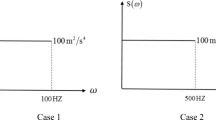Abstract
Electro-thermal-compliant mechanisms are mechanisms onto which electric voltage is applied as input. This mechanism is based on the thermal expansion properties of the materials. This study considered all of the convection effects according to layouts produced after each topology optimization process. A new material mixing method based on bi-directional evolutionary structural optimization (BESO) was suggested to obtain optimal topologies for compliant mechanisms composed of two materials. Reliability-based topology optimization (RBTO) based on BESO was also applied to the topology optimizations of the mechanisms. Performance measurement approach (PMA), which estimates has probabilistic constraints that are formulated in terms of the reliability index, was adopted to evaluate the probabilistic constraints. The procedure has been tested in numerical applications, and the results were compared with those obtained by the level set and solid isotropic material with penalization (SIMP) methods for validation of the proposed approaches.
Similar content being viewed by others
References
Howell, L., “Compliant Mechanisms,” Wiley, pp. 306–332, 2001.
Sigmund, O., “On the Design of Compliant Mechanisms Using Topology Optimization,” Mechanics of Structures and Machines, Vol. 25, No. 4, pp. 493–524, 1997.
Nishiwaki, S., Frecker, M. I., Min, S. and Kikuchi, N., “Topology Optimization of Compliant Mechanisms Using the Homogenization Method,” International Journal for Numerical Methods in Engineering, Vol. 42, No. 3, pp. 535–559, 1998.
Luo, Z., Tong, L. and Ma, H., “Shape and topology optimization for electrothermomechanical microactuators using level set methods,” Journal of Computational Physics, Vol. 228, No. 9, pp. 3173–3181, 2009.
Ansola, R., Vegueria, E., Canales, J. and Tarrago, J., “A simple evolutionary topology optimization procedure for compliant mechanism design,” Finite Elements in Analysis and Design, Vol. 44, No. 1–2, pp. 53–62, 2007.
Bendsoe, M. P. and Kikuchi, N., “Generating Optimal Topologies in Structural Design Using a Homogenization Method,” Computer Methods in Applied Mechanics and Engineering, Vol. 71, No. 2, pp. 197–224, 1988.
Pan, C. S. and Hsu, W., “An electro-thermally and laterally driven polysilicon microactuator,” Micromechanics and Microengineering, Vol. 7, No. 1, pp. 7–13, 1997.
Moulton, T. and Ananthasuresh, G. K., “Micromechanical devices with embedded electro-thermal-compliant actuation,” Sensors and Actuators A: Physical, Vol. 90, No. 1–2, pp. 38–48, 2001.
Yin, L. and Ananthasuresh, G. K., “A novel topology design scheme for the multi-physics problems of electro-thermally actuated compliant micromechanisms,” Sensors and Actuators A: Physical, Vol. 97–98, pp. 599–609, 2002.
Huang, X. and **e, Y. M., “Evolutionary Topology Optimization of Continuum Structures,” John Wiley and Sons, pp. 17–38, 2010.
Huang, X. and **e, Y. M., “Convergent and mesh-independent solutions for the bi-directional evolutionary structural optimization method,” Finite Elements in Analysis and Design, Vol. 43, No. 14, pp. 1039–1049, 2007.
Kharmanda, G., Olhoff, N., Mohamed, A. and Lemaire, M., “Reliability-based topology optimization,” Structural and Multidisciplinary Optimization, Vol. 26, No. 5, pp. 295–307, 2004.
Motiee, M., “Development of a Novel Multi-disciplinary Design Optimization Scheme for Micro Compliant Devices,” Ph.D. Thesis, Mechanical Engineering, University of Waterloo, 2008.
Han, S. Y. and Lee, S. K., “Development of a material mixing method based on evolutionary structural optimization,” JSME International Journal Series A: Solid Mechanics and Material Engineering, Vol. 48, No. 3, pp. 132–135, 2005.
Kim, H. J., Kim, B. Y. and Suh, M. W., “Development of a Topology Optimization Program Considering Density and Homogeni-Zation Methods,” Int. J. Precis. Eng. Manuf., Vol. 12, No. 2, pp. 303–312, 2011.
Author information
Authors and Affiliations
Corresponding author
Rights and permissions
About this article
Cite this article
Cho, KH., Park, JY., Im, MG. et al. Reliability-based topology optimization of electro-thermal-compliant mechanisms with a new material mixing method. Int. J. Precis. Eng. Manuf. 13, 693–699 (2012). https://doi.org/10.1007/s12541-012-0090-7
Received:
Accepted:
Published:
Issue Date:
DOI: https://doi.org/10.1007/s12541-012-0090-7




